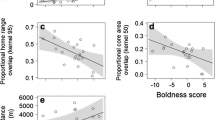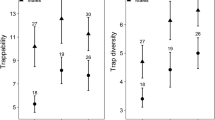Abstract
Individual differences in behavioural traits influence habitat choice, and in turn, differences in used habitats shape different behavioural tendencies through plasticity. Here, I investigated the relationship between personality and microhabitat use in a free-living population of the clonal gecko Lepidodactylus lugubris. The study site is a small beachfront forest facing two environments with contrasting levels of human disturbance. I conducted a mark-recapture survey to assess the geckos’ spacing pattern and evaluated their boldness and exploration scores in the laboratory. The geckos exhibited a small range of movement and a high consistency in their perch height. Boldness was related to two microhabitat features, but exploration was not. Relatively shy geckos were found in trees near the roadside and on low branches, whereas relatively bold geckos were found on both the beachside and the roadside and on low to high branches. These patterns suggest that geckos in high-disturbance microhabitats may have frequently experienced artificial stimuli and become shy. However, the present results cannot exclude the possibility that individual differences are caused by other factors and that different personality types prefer and settle in different microhabitats. Although the actual mechanisms are unclear, my findings highlight that behaviour-related habitat use emerges even in clonal animals.
Significance statement
Individuals within conspecifics show different spacing patterns and different behavioural tendencies. If clonal animals live in a spatially diverse environment, it is predicted that different microhabitats may gradually shape different personality types through developmental plasticity. Here, I investigated the association between the personality of clonal geckos and their microhabitat use in different levels of human disturbance. In contrast to the prediction, both juveniles and adults showed a similar pattern of boldness-related microhabitats; relatively shy individuals were found in putatively high-disturbance sites. This result suggests that the association between boldness and microhabitats is not gradually formed through a long-time scale but is likely generated within their early ontogenetic stage.




Similar content being viewed by others
Data availability
The dataset generated or analysed during this study is included in a supplementary information file.
References
Aguirre A, Coates R, Cumplido-Barragán G, Campos-Villanueva A, Díaz-Castelazo C (2013) Morphological characterization of extrafloral nectaries and associated ants in tropical vegetation of Los Tuxtlas, Mexico. Flora 208:147–156. https://doi.org/10.1016/j.flora.2013.02.008
Beaman JE, White CR, Seebacher F (2016) Evolution of plasticity: mechanistic link between development and reversible acclimation. Trends Ecol Evol 31:237–249. https://doi.org/10.1016/j.tree.2016.01.004
Bell AM, Hankison SJ, Laskowski KL (2009) The repeatability of behaviour: a meta-analysis. Anim Behav 77:771–783. https://doi.org/10.1016/j.anbehav.2008.12.022
Bierbach D, Laskowski KL, Wolf M (2017) Behavioural individuality in clonal fish arises despite near-identical rearing conditions. Nat Commun 8:15361. https://doi.org/10.1038/ncomms15361
Biro PA, Stamps JA (2010) Do consistent individual differences in metabolic rate promote consistent individual differences in behavior? Trends Ecol Evol 25:653–659. https://doi.org/10.1016/j.tree.2010.08.003
Blumstein DT (2016) Habituation and sensitization: new thoughts about old ideas. Anim Behav 120:255–262. https://doi.org/10.1016/j.anbehav.2016.05.012
Briffa M, Sneddon LU, Wilson AJ (2015) Animal personality as a cause and consequence of contest behaviour. Biol Lett 11:20141007. https://doi.org/10.1098/rsbl.2014.1007
Brodin T, Lind MI, Wiberg MK, Johansson F (2013) Personality trait differences between mainland and island populations in the common frog (Rana temporaria). Behav Ecol Sociobiol 67:135–143. https://doi.org/10.1007/s00265-012-1433-1
Brown LM, Crone EE (2016) Individual variation changes dispersal distance and area requirements of a checkerspot butterfly. Ecology 97:106–115. https://doi.org/10.1002/ecy.1216
Carere C, Maestripieri D (2013) Animal personalities: behavior, physiology, and evolution. University of Chicago Press, Chicago
Carrete M, Tella JL (2010) Individual consistency in flight initiation distances in burrowing owls: a new hypothesis on disturbance-induced habitat selection. Biol Lett 6:167–170. https://doi.org/10.1098/rsbl.2009.0739
Carter AJ, Feeney WE, Marshall HH, Cowlishaw G, Heinsohn R (2013) Animal personality: what are behavioural ecologists measuring? Biol Rev 88:465–475. https://doi.org/10.1111/brv.12007
Cote J, Clobert J (2007) Social personalities influence natal dispersal in a lizard. Proc R Soc Lond B 274:383–390. https://doi.org/10.1098/rspb.2006.3734
Cote J, Clobert J, Brodin T, Fogarty S, Sih A (2010) Personality-dependent dispersal: characterization, ontogeny and consequences for spatially structured populations. Philos Trans R Soc B 365:4065–4076. https://doi.org/10.1098/rstb.2010.0176
Dingemanse NJ, Réale D (2005) Natural selection and animal personality. Behaviour 142:1165–1190. https://doi.org/10.1163/156853905774539445
Dingemanse NJ, Wolf M (2010) Recent models for adaptive personality differences: a review. Philos Trans R Soc B 365:3947–3958. https://doi.org/10.1098/rstb.2010.0221
Englund G (1997) Importance of spatial scale and prey movements in predator caging experiments. Ecology 78:2316–2325
Found R, St. Clair CC (2016) Behavioural syndromes predict loss of migration in wild elk. Anim Behav 115:35–46. https://doi.org/10.1016/j.anbehav.2016.02.007
Fraser DF, Gilliam JF, Daley MJ, AN Le, Skalski GT (2001) Explaining leptokurtic movement distributions: intrapopulation variation in boldness and exploration. Am Nat 158:124–135. https://doi.org/10.1086/321307
Freund J, Brandmaier MA, Lewejohann L et al (2013) Emergence of individuality in genetically identical mice. Science 340:756–759. https://doi.org/10.1126/science.1235294
Garamszegi LZ, Markó G, Herczeg G (2012) A meta-analysis of correlated behaviours with implications for behavioural syndromes: mean effect size, publication bias, phylogenetic effects and the role of mediator variables. Evol Ecol 26:1213–1235. https://doi.org/10.1007/s10682-012-9589-8
Gosling SD (2001) From mice to men: what can we learn about personality from animal research? Psychol Bull 127:45–86
Gruber J, Brown G, Whiting MJ, Shine R (2017) Geographic divergence in dispersal-related behaviour in cane toads from range-front versus range-core populations in Australia. Behav Ecol Sociobiol 71:38. https://doi.org/10.1007/s00265-017-2266-8
Hawkes C (2009) Linking movement behaviour, dispersal and population processes: is individual variation a key? J Anim Ecol 78:894–906. https://doi.org/10.1111/j.1365-2656.2009.01534.x
Holtmann B, Santos ESA, Lara CE, Nakagawa S (2017) Personality-matching habitat choice, rather than behavioural plasticity, is a likely driver of a phenotype–environment covariance. Proc R Soc Lond B 284:20170943. https://doi.org/10.1098/rspb.2017.0943
Hunsaker D, Breese P (1967) Herpetofauna of the Hawaiian Islands. Pac Sci 21:423–428
Ineich I (1988) Evidence for a unisexual-bisexual complex in the Gekkonid lizard Lepidodactylus lugubris in French Polynesia. C R Acad Sci III 307:271–277
Ineich I (1999) Spatio-temporal analysis of the unisexual-bisexual Lepidodactylus lugubris complex (Reptilia, Gekkonidae). In: Ota H (ed) Tropical island herpetofauna: origin, current diversity, and conservation. Elsevier, Amsterdam, pp 199–228
Ineich I, Ota H (1992) Additional remarks on the unisexual-bisexual complex of the gecko, Lepidodactylus lugubris, in Takapoto atoll, French Polynesia. Bull Coll Sci Univ Ryukyus 53:31–39
Jacob S, Bestion E, Legrand D, Clobert J, Cote J (2015) Habitat matching and spatial heterogeneity of phenotypes: implications for metapopulation and metacommunity functioning. Evol Ecol 29:851–871. https://doi.org/10.1007/s10682-015-9776-5
Kuznetsova A, Brockhoff PB, Christensen RHB (2015) lmerTest: tests in linear mixed effects models. R package version 2.0-25, http://CRAN.R-project.org/package=lmerTest
Lianna J, Lazell JD (1987) Zur Größe und Dichte einer Population von Lepidodactylus lugubris (Duméril & Bibron, 1836) in Aiea, Hawaii (Sauria: Gekkonidae). Salamandra 23:176–178
Moritz C, Case TJ, Bolger DT, Donnellan S (1993) Genetic diversity and the history of pacific island house geckos (Hemidactylus and Lepidodactylus). Biol J Linn Soc 48:113–133. https://doi.org/10.1111/j.1095-8312.1993.tb00882.x
Murakami Y, Sugawara H, Takahashi H, Hayashi F (2015) Population genetic structure and distribution patterns of sexual and asexual gecko species in the Ogasawara Islands. Ecol Res 30:471–478. https://doi.org/10.1007/s11284-015-1246-6
Nakagawa S, Schielzeth H (2010) Repeatability for Gaussian and non-Gaussian data: a practical guide for biologists. Biol Rev 85:935–956. https://doi.org/10.1111/j.1469-185X.2010.00141.x
Nilsson J-A, Bronmark C, Hansson L-A, Chapman B (2014) Individuality in movement: the role of animal personality. In: Hansson L-A, Akesson S (eds) Animal movement across scales. Oxford University Press, Oxford, pp 90–109
Ota H, Toda M, Masunaga G et al (2004) Feral populations of amphibians and reptiles in the Ryukyu archipelago, Japan. Global Environ Res 8:133–143
Perry G, Ritter M (1999) Lepidodactylus lugubris (mourning gecko). Nectivory and daytime activity. Herpetol Rev 30:166–167
Perry G, Theodore GJ (2002) Lizard home ranges revisited: effects of sex, body size, diet, habitat, and phylogeny. Ecology 83:1870–1885
Petelle MB, McCoy DE, Alejandro V et al (2013) Development of boldness and docility in yellow-bellied marmots. Anim Behav 86:1147–1154. https://doi.org/10.1016/j.anbehav.2013.09.016
Petren K, Case TJ (1996) An experimental demonstration of exploitation competition in an ongoing invasion. Ecology 77:118–132. https://doi.org/10.2307/2265661
R Core Team (2017) R: a language and environment for statistical computing. R Foundation for Statistical Computing, Vienna, Austria, https://www.r-project.org/
Réale D, Reader SM, Sol D, McDougall PT, Dingemanse NJ (2007) Integrating animal temperament within ecology and evolution. Biol Rev 82:291–318. https://doi.org/10.1111/j.1469-185X.2007.00010.x
Sakai O (2015) New distribution sites of Lepidodactylus lugubris around Okinawajima and feeding from extrafloral nectaries. Akamata 25:5–8 (in Japanese)
Sakai O (2016) Size distribution suggests a seasonal effect on reproduction of Lepidodactylus lugubris on Okinawajima Island, Japan, the northernmost distributional area. Curr Herpetol 35:59–63. https://doi.org/10.5358/hsj.35.59
Sakai O (2018) Comparison of personality between juveniles and adults in clonal gecko species. J Ethol 36:221–228. https://doi.org/10.1007/s10164-018-0551-2
Samia DSM, Nakagawa S, Nomura F, Rangel TF, Blumstein DT (2015) Increased tolerance to humans among disturbed wildlife. Nat Commun 6:8877. https://doi.org/10.1038/ncomms9877
Schuett W, Dall SRX, Baeumer J, Kloesener MH, Nakagawa S, Beinlich F, Eggers T (2011) Personality variation in a clonal insect: the pea aphid, Acyrthosiphon pisum. Dev Psychobiol 53:631–640. https://doi.org/10.1002/dev.20538
Sih A, Bell AM, Jhonson JC, Ziemba RE (2004) Behavioral syndromes: an integrative overview. Q Rev Biol 79:241–277
Sims DW, Witt MJ, Richardson AJ, Southall EJ, Metcalfe JD (2006) Encounter success of free-ranging marine predator movements across a dynamic prey landscape. Proc R Soc Lond B 273:1195–1201. https://doi.org/10.1098/rspb.2005.3444
Skellam JG (1951) Random dispersal in theoretical populations. Biometrika 38:196–218
Smith BR, Blumstein DT (2008) Fitness consequences of personality: a meta-analysis. Behav Ecol 19:448–455. https://doi.org/10.1093/beheco/arm144
Sol D, Lapiedra O, González-Lagos C (2013) Behavioural adjustments for a life in the city. Anim Behav 85:1101–1112. https://doi.org/10.1016/j.anbehav.2013.01.023
Spiegel O, Leu ST, Bull CM, Sih A (2017) What’s your move? Movement as a link between personality and spatial dynamics in animal populations. Ecol Lett 20:3–18. https://doi.org/10.1111/ele.12708
Stamps JA (1977) Social behavior and spacing patterns in lizards. In: Gans C, Tinkle DW (eds) Biology of the reptilia, vol 7. Ecology and behavior A. Academic Press, New York, pp 265–334
Stamps JA, Groothuis TGG (2010) The development of animal personality: relevance, concepts and perspectives. Biol Rev 85:301–325. https://doi.org/10.1111/j.1469-185X.2009.00103.x
Stamps JA, Briffa M, Biro PA (2012) Unpredictable animals: individual differences in intraindividual variability (IIV). Anim Behav 83:1325–1334. https://doi.org/10.1016/j.anbehav.2012.02.017
Stankowich T, Blumstein DT (2005) Fear in animals: a meta-analysis and review of risk assessment. Proc R Soc Lond B 272:2627–2634. https://doi.org/10.1098/rspb.2005.3251
Switzer PV (1997) Factors affecting site fidelity in a territorial animal, Perithemis tenera. Anim Behav 53:865–877. https://doi.org/10.1006/anbe.1996.0352
Whitaker AH (1968) The lizards of the Poor Knights Islands, New Zealand. New Zeal J Sci 11:623–651
Wilson DS, Clark AB, Coleman K, Dearstyne T (1994) Shyness and boldness in humans and other animals. Trends Ecol Evol 9:442–446. https://doi.org/10.1016/0169-5347(94)90134-1
Yamashiro S, Toda M, Ota H (2000) Clonal composition of the parthenogenetic gecko, Lepidodactylus lugubris, at the northernmost extremity of its range. Zool Sci 17:1013–1020. https://doi.org/10.2108/zsj.17.1013
Acknowledgments
I am grateful to A. Mori for meaningful comments on and discussion of my work and for reviewing the manuscript and providing an accommodation near the field site. I would like to thank C. Barnett for improving the language of the manuscript and Y. Kadota for providing information about the focal population. I also express my appreciation to two anonymous reviewers for insightful comments that helped to improve the manuscript. Several members of the Laboratory of Ethology, Kyoto University, encouraged me with helpful comments.
Author information
Authors and Affiliations
Corresponding author
Ethics declarations
Conflict of interest
The author declares no conflicts of interest.
Ethical approval
The present study was carried out in compliance with the guidelines of the Animal Care and Use Committee of Kyoto University (approval number of Animal Experimental Protocol: H-2507, H-2607 and H-2707). The field survey was conducted with the permission of the Department of Agriculture, Forestry and Fisheries of Okinawa Prefecture. Field survey and experimental procedures were designed to minimise stress and harm to subjects.
Additional information
Communicated by T. Madsen
Publisher’s note
Springer Nature remains neutral with regard to jurisdictional claims in published maps and institutional affiliations.
Electronic supplementary material
ESM 1
(XLSX 44 kb)
Rights and permissions
About this article
Cite this article
Sakai, O. Behavioural tendencies associated with microhabitat use in a clonal gecko species living in the wild. Behav Ecol Sociobiol 73, 64 (2019). https://doi.org/10.1007/s00265-019-2679-7
Received:
Revised:
Accepted:
Published:
DOI: https://doi.org/10.1007/s00265-019-2679-7




